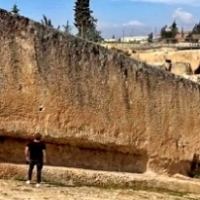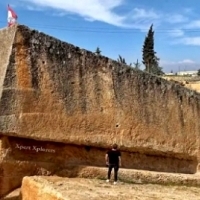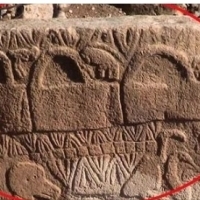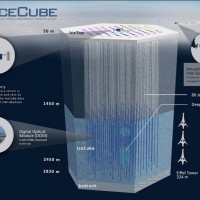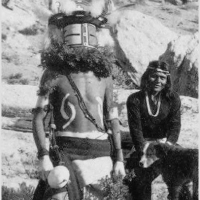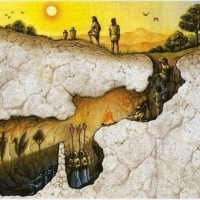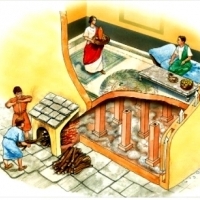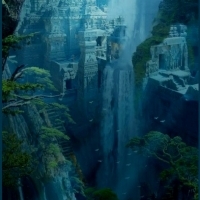0 : Odsłon:
The Stone of the South, Baalbek, Lebanon
~When conventional wisdom is unfounded foolishness~
In an insignificant area out in the countryside of Lebanon there are three objects that are among the most significant objects on our planet. That significance is not because of their use since they have no use, -instead, it is because of their origin… and their size.
In the flat-world two-dimensional thinking of establishment historians, those objects are impressive but not significant because they ascribe to them a super-simplified, mindlessly shallow explanation. They fail to grasp that they need to rethink their presumptions and move from a Checkers world of simplicity to a Chess world of considerable complexity.
That has never been done before because simple answers satisfy a simple perspective and allows one to confidently remain in a walled-in little zeitgeist where nothing exists of the extraordinary and inexplicable. It’s always nice, when you have the imprimatur of established authority behind you, to think and write in an authoritative manner, which of necessity, includes providing answers…even when there are none.
So a much closer examination of a subject may lead to a conclusion that’s in stark opposition to that which is dogmatically proffered by the conventional thinkers. That should not be accepted as a deterrent or discouragement to seeking answers to the questions that they will not even think to ask. So in this exposition questions will be asked and facts will be presented, and some answers will be obtained… by logical induction. Let’s begin.
In that insignificant area of downward sloping, uneven terrain composed of sand, gravel and limestone protuberances, there sit three super megablocks unlike any others on Earth (besides their counterparts a mere kilometer away that are their equivalent). Those other blocks are a part of a great retaining wall of a platform that became in time the base of a super temple complex greater than any other in the Roman empire…and the entire world.
What inspired the Romans to build such a complex so far from Rome? It must have been the unbelievable, colossal blocks that comprise the wall, which approach weights of around 2,000,000 lbs. each, and there’s three of them, along with many more below them that are around half that weight, and others about 3/4ths their size and weight elsewhere.
The Romans knew that there was no other such site in the entire known world and they had no clue as to who built that platform or why or when or how. So naturally, of all the places on Earth where they could believe that the gods once were active, that was it. So that was their inspiration, and they did the best and biggest construction work ever seen with the exception of colossal ancient Egyptian temples and mortuary complexes.
But this is not about the blocks that are found in the Baalbek temple complex but about those that are not. It is those blocks that defy explanation because the facts about them do not fit into any conventional theory. It is those facts that need to be recognized and considered, so let’s do that.
The number of inexplicable features and problems of explanation is not small, so to find answers we need to compare them to facts that we know. In doing that we’ll refer to them individually as anomalies…factors that don’t conform to conventional known reality or which present logic errors that can’t be explained away.
Anomaly 1.
The first thing that one notices when seeing the most famous and visible block (the stone of the South) is its enormous size. With its size comes its weight, and that weight presents an insurmountable problem when seeking explanations. Explanations have been presented but they fail to take actual reality into account. That reality involves the limitations of technology in the prehistoric past as well as today. Those limitations can be glossed over as if they don’t exist, and have been, but they exist nevertheless and they limit the possible explanations to only those that were possible.
Scoffers present theories that pretend that we need not consider such limitations but that is just an exercise in putting a blindfold on one’s eyes. That spares them from having to account for the fact that blocks of such size and weight are never quarrried anywhere in the world today and never have been because of very real limitations of technology…and need.
Such blocks could have only served one useful function and that would have been to act as foundation blocks for a large dam. Other than that they are not needed for anything, so why would any engineer have demanded the production of such monsters? Since there is no answer to that question we are left to consider possibilities outside of the conventional.
That leads us to suspect that they were produced because their production was not as difficult as we might assume. Now that brings us to an important point, which is the issue of what was possible for terrestrial technology & manpower and what was not. If terrestrial technology was not capable of producing and moving such blocks then we have to consider non-terrestrial technology as having been employed and capable of functioning beyond the limitations of terrestrial technology and techniques of that time.
Only that would explain how such a choice of size was made, with the assumption being that the effort required for advanced technology was far less than that for known technology.
Builders don’t choose to resort to the most difficult process to achieve an aim but the simplest. So if the effort was fairly routine for advanced technology then the choice to produce blocks of that size would not be an extraordinary choice. But to suppose that the choice was made by terrestrial engineers who had to work within the limitations of their technology is to suppose that the effort was not at all an insurmountable problem. That’s where the conventional explanation falls apart…bigtime.
I’m referring to the excavation of such blocks, as well as their transportation, and how impossible it was for prehistoric technology. Stone masons back then had no power tools. No giant powerful portable saws, no pickaxes or chisels made with hardened, drop-forged, chromium, titanium, vanadium steel. No embedded diamond grit. All they had was copper and its alloys. And slab saws would have been an impossibility because of size as well as the fact that such a process grinds away the copper even faster than the hard stone attempting to be ‘cut’ through (by grinding quartzite sand in a groove).
Such chisels and picks are worthless against hard stone, and their sharpened tips will dull immediately upon striking hard rock. Even iron is too soft for such hardness and it will dull as well but at a slower pace. So we are left with no explanation for how such stone could have been ‘quarried’.
Quarrying involves splitting blocks off from a wall of bedrock. That involved chiseling a line of indentations for inserting wooden wedges that were pounded in tight and then soaked with boiling water which would make them expand, creating splitting pressure. But that has its limitations and they are what made such an approach impossible.
First, their metals could not penetrate hard stone in order to make the necessary indentations. Second, wood is not like expanding metal or ice. It is crushable and can only exert pressure within the parameter of cellular strength. Pounding wooden wedges into holes in hard stone will only exert a specific amount of expansion pressure above which no further pressure would be exerted because wood is not a dense solid substance…with the exceptions of extremely hard and dense woods such as teak and ironwood.
They are so dense and heavy that they sink in water just like rocks. But such woods were not available, and anyway, they do not expand when exposed to water because their structure is too dense to allow its penetation.
Some will suggest that they could have used stone chisels made with even harder stone than the ‘quarry bedrock’, -with sharpened edges like stone axes, but such tools with sharp edges are of stone that is siliceous in nature, meaning its basic composition is composed of some form of silica.
Silica, which makes glass and flint and obsidian, can be extremely sharp and did serve to form a great cutting edge for thousands of years, but like glass, it is also brittle and cannot be used as a pounding instrument.
Others might suggest that a harder type of stone, such as diorite, was used to pound holes in the hard bedrock for splitting, but what tools would have served to shape diorite into having a sharpened chisel edge? Even if such chisels were created by pounding stone against stone, their shapened edge would not stay sharp beyond a few poundings. Too much concentrated force in too small of an area. That causes fracturing.
So there was no conceivable means to chisel holes needed for pounding non-existent steel wedges for splitting hard stone from a non-existent bedrock wall. But even with such super-hard chisels and wedges, the task would have failed to achieve what is seen because the blocks are too thick… to wide and too tall and too long. No quarrying effort on such a scale has ever been attempted, (much less achieved) because it would be known in advance that it would be futile (without huge power equipment or explosives).
But the real situation is even worse than that because the requirement of quarrying would have involved not only splitting a mass of stone away from a bedrock wall but would have also involved having to split it simultaneously off at the intended level of depth, horizontally…to free the intended bottom.
Well, one impossibility is bad enough but two is too much. Conceptually it could be done up to some undetermined limit, but the size of those blocks is way beyond any such limit! It is so far beyond it that it’s not even conceivable to suggest it as a possibility. Needless to say, it has never been done and never will be done.
Anomaly 2
Along with the enormous size of the block, the other thing that stands out is the inexplicable angle at which it’s inclined. Search the world over and you will not find any quarry where blocks are not cut at right angles to the ground. The drilling that is done in a tight line of deep holes is always vertical, and the forces that are exerted to split blocks off of a wall of bedrock are also directed straight down, not at an inexplicable angle. So what’s the story with the steep angle at which the block sits? That is not how stone is quarried, so there’s no explanation other than the one that I’ve offered (which is found in my previous exposition).
Anomaly 3
Unlike the inexplicable “unfinished obelisk” of Aswan, Egypt, there is zero igneous bedrock surrounding the massive block. How can that be if it was in the process of being quarried from bedrock by digging trenches around it? There it sits with its end sticking up openly in the air with not a hint of it having been excavated from non-existent bedrock. That can’t be explained by any conventional theory because of two factors.
The first is that if the surrounding bedrock had been quarried away some 5,000 years ago or so then surely within all of those passing years there would have been some need for some more quarried stone and it would have come from quarrying blocks off from the big block that was just sitting there waiting to be used. But in 5,000 years or so that never, ever happened. Why?
I’d say for two reasons: no tools capable of doing that existed until Roman times, and too much respect (and awe) was felt for whoever was responsible for producing such mammoth size blocks. You wouldn’t want to be putting yourself in their cross-hairs. But its counterpart across the road (sitting in rubble and trash) actually was ‘quarried’ briefly and then never again. It was a really bad shape (as in too big) and too hard to conveniently quarry so it was too much work and the results weren’t satisfactory enough to justify the effort.
One might wonder what force on Earth could have stopped any group of people who possessed such advanced technology capable of such a monster scale of stone quarrying? We don’t know but we do know that it did stop…abruptly, -just as it stopped at the massive platform a kilometer way, and as it did in Aswan when the unfinished obelisk, near completion, was abandoned along with its smaller companion in an ignored area of the quarry. Beings of such capability, with such advanced technology, could only have been stopped by beings with even more powerful technology. That possibility is probably a probability rather than a fantasy because nothing else makes sense.
And those who have swallowed the conventional ‘fact’ that the unfinished obelisk was abandoned because a crack developed at some time by some unknown force, they need to explain why the smaller one, which was in perfect shape, was also abandoned…for 5,000 years! Why did the dynastic Egyptians not finish ‘quarrying’ it and extract it?? The conventional answer must be that those two obelisks were the last ones ever quarried, but the truth is that they were the first ones ever quarried, and all others were inspired by and in honor of them.
So the accurate answer as to why they left it in the ground is that they couldn’t extract it because they had no technology capable of doing that. They had thousands of years that passed but never developed such technology… or they left it where they found it because they were convinced with a sense of fear and awe that both of them were the work of unknown gods…which they were…probably long before the Egyptian people formed a country and nation along the Nile.
Anomaly 4
If all of the ‘bedrock’ was ‘quarried’ away from around the slanted Stone of the South then that would have made its extraction impossible because the only way to snap it off of the well-undercut bottom would have been to use gigantic wedges and colossal levers to pry it to one side once it was undercut sufficiently, -thereby snapping if free from the bedrock. Yet someone needs to step forward and explain how that would be possible if there is no bedrock on at least one side. Obviously, it would have been impossible, so why would it have been excavated, as it is assumed to have been, and then the only means to free it was eliminated? Please explain the logic of that. Well there isn’t any, and yet the fairy tales of the establishment are presented anyway with all of the academic authority that they can muster. So pathetic.
Also, if all of the supposed hard bedrock that surrounded it was later quarried away by later inhabitants, then why did they not also quarry the big block just as they supposed could have quarried the surround stone? Why has it gone untouched for probably 5,000 years or more? That’s a huge number of generations to just leave it alone when hard stone was probably desireable to have for building. But, you can’t do what your tools can’t do.
Anomaly 5
The truth about the Stone of the South is discoverd by looking underneath it. What is seen is a line of separation between it and the hardened, compressed gravel on which it sits. That line, along with the finished flatness of the bottom, reveals that it is not attached to any bedrock but is simply lying atop the ground where it came to be located. That fact destroys the entire narrative of it having been in a process of being quarried where it sits.
If one wants to believe that it was quarried and was not the work of a process of pouring stone concrete layer by layer into a gigantic mold until the layered mass reached the top, then one is obligated to point out the excavation site that it came out of. Show the quarry where ALL of the Baalbek megablocks and temple blocks were extracted. That proof would end this discussion.
But no one can do that because no such quarry exists. That fact leads to only one conclusion for anyone capable of logical induction, which is that ALL of the construction material in Baalbek (beginning with the intricate, elaborate architectural embellishment surrounding the temples up top) was cast in molds. Everything! Nothing was quarried. Nothing was split from bedrock. All shapes and forms were made with reconstituted “geopolyer” stone concrete cast in molds, -just like making bricks but on a much grander scale. That new claim can be quickly shot down by simply showing the area where a couple dozen megablocks and hundreds of lesser blocks and pillars were extracted from a quarry.
That can’t be done because no such quarry exists and never has existed. The only quarry is the one where they are located but that huge mess of land is all stone rubble and sand on a lumpy terrain that is below a higher level of ground above it. It could serve as a gravel quarry, and no doubt has, but not a bedrock quarry since the actual hard-stone bedrock is too deep to reach.
There are areas nearby where soft limestone bedrock protrudes, and they have been worked to created chambers, perhaps for burials, but that limestone is weak and easily eroded with time and weather so it’s not the same constitution as the giant blocks themselves which are rather impervious to weathering due to their hardness.
They were formed as stone concrete using a mixture of natural stone cement (powder and sand) and “geopolymer” chemical binders, mixed with aggregate of broken limestone rock from the gravel quarry that is filled with it, forming a conglomeration similar to concrete that is made in a similar manner.
Natural limestone is soft and weak in comparison, but much or most of the rock nearby is the jumbled result of an avalanche of broken rocks, pebbles, sand and mud.
If their location was in an actual quarry for huge stone blocks, how could they have been transported since they weigh too much for any terrestrial form of portable transport, and far, far more so in the prehistoric past?
Anomaly 6 Evidence of Casting
On the top of the Stone of the South there is a raised section extending downward from the high end about halfway to the center of the top surface. It has an edge that is several inches thick. Nothing at all can explain such an anomaly except that is was the inside edge of a pour of concrete onto that higher end. If the block was miraculously quarried then such a layer would not exist. The top would be flat. The sides are very flat so why is the top not in the same condition? Even the bottom is flat. But the top has even more evidence of casting.
Along the top edge of one side there is a ridge that rises a few inches above the surface. Again, nothing can explain it except the sloshing of wet concrete against a mold wall with some of it adhering to the wall enough to prevent the concrete from settling down to level. No saw or chisel work would have left such a ridge.
Also, there are areas near the bottom end that could only have resulted from objects or rocks falling on a wet surface. They also were not produced by any method of sawing or chiseling. No one can suggest any motive for anyone to have ever hammered out those indentations at some point in history. So casting is the only reasonable explanation.
In addition there is the issue regarding how the surface of the ground above the block was originally shaped and how digging into it somehow resulted in the inexplicable angle in which it’s positioned. Quarrying blocks doesn’t include giving a finished level surface where the ground level is but merely splitting off a section of stone, -with leveling the top and bottom coming afterward. Yet we see a flat top surface instead of the natural irregular shape of the original ground surface. Why? We have to consider that a flat surface is the common result of casting concrete that is thin enough for self-leveling, pourable.
Anomaly 7
In 2014 while removing the ground that surrounded the lower end of the Stone of the South they discovered below and off to one side the heaviest block known on Earth, perhaps 1,600 tons. Just off the center of its lower top edge there is a “V” shaped area that is missing. That area of missing stone extends downward about 18 inches, stopping at a surface that appears to be unnaturally flat, and a line at that surface extends to and around the nearby corner.
In natural limestone bedrock, layers might be nothing unusual, just as with sandstone, but that’s not the case with that block because the 18 inch height of that missing space is not homogeneous limestone but is clearly a conglomeration of broken rock, as in the aggregate used to produce concrete. That indicates that the block was produced by pouring layers about 18 inches thick until the block reached the desired height, which is extremely remarkable since it is about three times the height of a man. “Who does that?” Who wants or needs or makes a block of such gargantuan size? It’s use is inconceivable in an area where a massive dam project never took place.
Anomaly 8
The bottom of that lower block is so deep below the surface that no excavation was attempted beneath it to see if it is attached to the ground or not. The space that was excavated next to it in order to reveal its full height is shaped by ever-deeper terrace levels having walls composed of field stones stacked atop each other.
That was necessary because there is no bedrock on that outside that could have been carved into terrace levels. They had to be constructed from scratch to prevent the loose gravel above from refilling the excavated cavity beside it. So there is plenty of gravel and rocks but no bedrock.
Terrace walls built of field stone are everywhere but not a single one carved from bedrock.
Without a parallel wall, no means exists to use wedges to snap it from bedrock (as is also the case with the upper block), speaking of which, why would any quarry master order the excavation of such a deep block while one sits right above and beside it? Would it not have to be moved out of the way in order to deal with the excavation and removal of “the world’s biggest block” below it? If it could have been removed from the ‘quarry’ then why wasn’t it? It would have constituted a hinderance to the excavation of the lower block if the lower block had actually been quarried there, which it was not.
Anomaly 9
If ALL of the megablocks of the temple complex came from the gravel quarry then there was a practiced and perfected system of transportation, but what that system would not have included was the finishing of the blocks’ surfaces while still inside the ‘quarry’ and still attached to bedrock! That would not have been done, -especially the flattening of the bottom surface, because any serious error in transportation could have resulted in the block rolling into a ditch from where it could not be retrieved, or worse, it could crack in half since it supposedly was composed of that weak crappy limestone found in the quarry.
What good would all of that surface leveling have done if a block broke in two? Obviously the only sensible approach would have been to not begin the finishing work until it had already arrived at the construction site.
Anomaly 10
Since the temples of the complex can be ascribed with certainty to the Romans, the know-it-alls of quackademia have taken it upon themselves to ascribe the super megalithic stoneworks to the Romans also, you know…for convenience. But the two-plus-two that no one has calculated is that if that is true then the Romans had hundreds of years to complete the movement of the last three blocks to the complex, but they didn’t. WHY???
They have no answer because no answer is possible since it makes no sense. They want everyone to believe in their pretend make-believe scenario in which the Romans had unlimited prowess and capability and therefore were fully capable of moving (and quarrying) stone of such gargantuan size, and yet when confronted with the question of why they didn’t do it since they were soooo competent at such a task, -their logic falls apart because there’s no answer.
The real answer, of course, is that they didn’t do it because they couldn’t. They didn’t have the technology, or the power, and it could not be done today either given the same unaltered location.
Anomaly 11: Transportation
To transport any large stone object required a sled, or as some say: a “sledge”. Heavy objects cannot be dragged across the ground because the friction is too strong, so they had to have been lifted onto a wooden sled which had to slide over greased wooden beams. That works only up to the point at which manpower and horsepower are no longer capable of lifting or tilting an absurdly heavy weight.
The weight of the Baalbek blocks is far beyond that limit. They could not be lifted by anything nor could they have been propped up at one end because nothing existed that could have achieved that. No assortment of cranes could have come even remotely close to raising an end even an inch. One might suggest that they could have undercut the ground below it deep enough to allow for the insertion of a sled underneath…all of the way to the midpoint of the block perhaps. But that presents another insurmountable problem.
That undercutting would result in the shifting of all of that unsupported weight to the area still resting on the ground, resulting in enormous ground pressure and a subsequent friction level that could not be overcome by pulling on it with ropes and muscle power. That only leaves the use of giant levers or crowbars.
They serve well to lift very heavy things partially off the ground, but would not even be considered for such weights because no lever of the size needed was possible nor manageable. It would weigh too much and be too big. They would have to have been at least double the length of the blocks and handled by men at least as tall as the blocks are long. So unless we can find some skeletons that are 60 feet or so in length we can rule out the use of levers to lift the blocks onto gigantic sleds.
Anomaly 12
The only material that could have been used for sleds or log rollers was wood. In Lebanon there were the famous giant cedars of Lebanon, so while wood of great size was available, wood of great strength was not.
Cedar is a soft wood, similar to pine, but only a very hard wood would resist the crushing power of such enormous weights as those blocks. So even if a sled or some log rollers could be inserted beneath a block they would quickly be compressed and possibly crushed since they would lack the density and hardness to resist such great pressure.
The other day near where I live, one or more huge redwoods and /or cedar trees fell across the highway, causing a traffic mess. They are so huge and their weight is so great that when they strike the ground they explode. They shatter.
They do not have the structural strength to resist the shock wave of pressure that is exerted upon impact. They only have to resist the natural weight of vertical pressure from great heights pressing downward. So their strength is in the vertical axis and not the horizontal one. Hence great weight placed across their width would cause them to rupture.
But even it they could bear the weight, no humans could handle them because they would weigh too much since they would have to be huge. Rolling them down slope to a river for down-stream transport would be child’s play compared to moving gigantic rollers from the rear of a block up to the front. They would have to have been a yard or a meter in thickness.
But a few of them would not be adequate. The entire underside would have to be lined with huge logs since all of the weight is placed on just the upper crest of the logs that would contact the block, -along with the bottom crest that would contact the ground. Those two strips would take all of the crushing pressure and would compress as a result if there were not as many as possible to share the load.
Anomaly 13
Besides the physics of bearing enormous weight, there is the mechanical impossibility of using rollers as people envision it. That is an insurmountable problem because of the lack of a precision surface on which they would roll. In order to prevent little dips and rises from allowing perfectly uniform logs to lose contact with the block, the road bed would have to be utterly flat along with the logs being perfectly round and of an identical diameter.
Because of the requisite slow speed of megablock movement, as soon as a log roller lost contact it would stop moving, and as a result the one behind it would run into it. The stoppage of just one log would result in a log jam that would produce so much resistence that it could not be overcome by men with ropes. Such a situation would be unfixable especially if a dip in the surface allowed two or more blocks to lose contact.
So that only leaves a sled as a possible alternative. But that suffers from the impossibility of putting a block up onto a sled and then attempting to move it upward at the steep angle of the southern block. Too much weight and too much friction.
Anomaly 14
Let’s pretend that one such block was somehow placed atop a sled or a set of rollers. Then what? How can the soil resist such weight and remain perfectly flat assuming it was made flat to begin with? Well, it couldn’t. The transport mechanism would sink into the soil, so a very thick and strong road bed would be needed.
Let’s pretend further that such a road was prepared using large thick stone blocks, and that the transport mechanism did not become crushed and lose its shape nor disintegrate. Then we would have to account for how such a heavy weight could be pulled uphill (beginning with being pulled uphill out of the ‘quarry’).
When pulling forward on level ground with good lubrication, movement is entirely possible, but when the angle changes then the force needed changes as well, to a significant degree. With every increase of degree of incline the power needed to produce forward motion increases considerably even with rollers. If you’ve ever manually pushed a moderately heavy car on level ground you know that its not easy to do, but to manually push a car uphill is actually impossible. So greater forward force would be needed than that of merely dragging a sled on flat ground.
Then there’s the greater capability needed to prevent downhill run-away movement of a block on rollers. How would you possibly brake the forward inertia of such a weight? Nothing to successfully do that is conceivable. Therefore movement over anything other than a flat surface would never be possible nor attempted. It has to be assumed that such a flat roadbed of sufficient hardness was never constructed because the terrain between the origin point and the destination would be very unlikely to be nice and flat across the entire distance.
And, if such a roadway had been constructed then it would still be in use, or at least visible today because of the size of the blocks required to construct it. Also it would have been impossible with roller logs because they would have to have been moved sideways after emerging at the back, then rolled up to the front and shifted back into alignment with the front of the block. But how could they have even been moved forward if the road was not double the width of the logs or more??
Well, there is no such broad, thick roadway and that is because one was never built nor needed due to the fact that the blocks were not made at the so-called ‘quarry’ but were cast-on-site at the Baalbek platform complex.
If so, then how did they get from there to the so-called quarry? That question is answered in my previous exposition titled: The Truth About Baalbek Changes Everything.
https://sciencetheory.wordpress.com/2021/09/24/the-truth-about-baalbek-changes-everything/
Anomaly 15
Across the highway from the famous location is a non-descript wasteland in which sits a companion to the southern stone (or stone of the pregant woman). As one of the most significant obejcts on Earth, it is honored by being surrounded by disgarded waste… (-probably illegal dumping) or at least it was for a long time.
It also is not evidently attached to the ground as it appears to rest on top of rubble, but we can’t know for sure because there has been no attempt that I’m aware of to clean up the area and do some exploratory excavation underneath it.
If the subject has even been broached by authorities they would have faced the conundrum of not being sure that it was a good idea because of what it might expose. If it was found that the block was not attached to the ground then questions would arise such as ‘why was it not brought to the temple complex since it was ready to go’? Why has it just sat there for perhaps 5,000 years and no ruling power ever transported it to the temple complex as they supposedly were fully capable of doing??? Also, if it is not attached to the ground then what ground was it originally attached to? Where was it ‘quarried’? How was it moved? Why was it left where it is?
“Authorities” prefer to leave such questions unasked because they certainly have no answers, and neither does anyone else.
by Adrien Nash Nov. 26, 2021 -edited Dec. 29, 2021
: Wyślij Wiadomość.
Przetłumacz ten tekst na 91 języków
: Podobne ogłoszenia.
OWOCE SUSZONE I KANDYZOWANE. ORZECHY. ZIARNA I PESTKI. PRZYPRAWY.
: : : : : : : : : : : : : : : : : : : : : : : : : : : : : : : : : : : : : : : : : : : : : : : : : Opis. Firma Japar rozpoczęła swoją działalność w 1994 roku w Poznaniu. Początkowo działaliśmy na rynku lokalnym, jednak już od kilku lat nasze produkty można…
Ciecierzyca: Pożywienie, które powinno być w diecie po 40 latach życia
Ciecierzyca: Pożywienie, które powinno być w diecie po 40 latach życia Kiedy osiągamy pewien wiek, potrzeby naszego ciała zmieniają się. Ci, którzy zwracali uwagę na swoje ciała przechodzące w wieku dojrzewania w wieku 20 lat, a następnie w wieku 30…
Dairy: That's right, milk is the first meal we enjoy after being born.
Dairy: That's right, milk is the first meal we enjoy after being born. Nevertheless, breast milk is definitely different from cow's milk. Well, in fact, the calf does not feed on the mother's milk, but on cheese, which is formed immediately in his…
Симптоми на грип: Начини на инфекција со грип и компликации:
Симптоми на грип: Начини на инфекција со грип и компликации: Грипот е болест што ја познаваме со милениуми, сè уште во сезонски релапси може брзо да нè отсече од нозете и долго време да нè исклучи од професионални активности. За прв пат во 4 век п.н.е.…
Banduddu: Zagadka pojemnika babilońskiego, torebki.
Banduddu: Zagadka pojemnika babilońskiego, torebki. Jedna z największych zagadek mezopotamskiej sztuki sakralnej dotyczy wizerunku antropomorficznych uskrzydlonych postaci zwanych Apkallu, trzymających w jednej ręce mullilu (owoc drzewa), a w drugiej…
Egipcjanie i Grecy mówili, że WODA jest NAJLEPSZA na WSZYSTKO.
Egipcjanie i Grecy mówili, że WODA jest NAJLEPSZA na WSZYSTKO. TAK JEST. Woda źródlana jest najbardziej naturalną formą wody pitnej, czystą i pozbawioną chemii oraz PEŁNĄ ŻYCIOWĄ SIŁĄ ENERGII i minerałów. Dlaczego to ważne? Nasze ciała składają się w…
Buns with blueberries are a delicious idea for a holiday lunch.
Bułeczki z jagodami to przepyszny pomysł na wakacyjne drugie śniadanie. Sprawdzą się w domu, w pracy, na pikniku czy na wakacjach. Drożdżowe bułeczki z jagodami rozpływają się w ustach, kochają je zarówno dzieci, jak i dorośli. Warto przygotowywać je…
Óleos essenciais naturais e aromáticos para aromaterapia.
Óleos essenciais naturais e aromáticos para aromaterapia. Aromaterapia é uma área da medicina alternativa, também chamada medicina natural, que se baseia no uso das propriedades de vários odores, aromas para aliviar várias doenças. O uso de nervos…
Antarktis Whistleblower enthüllt auf der Disclosure Konferenz unfassbares.
Antarktis Whistleblower enthüllt auf der Disclosure Konferenz unfassbares. Seit Oktober 2010 hat Eric Hecker ein Jahr lang für die Raytheon Polar Services Company an der Amundsen-Scott-Station am Südpol gearbeitet, wo er wissenschaftliche Geräte,…
ખાડીનું ઝાડ, ખાડીના પાંદડા, ખાડી પાંદડા: લોરેલ (લૌરસ નોબિલિસ):Laurel.
ખાડીનું ઝાડ, ખાડીના પાંદડા, ખાડી પાંદડા: લોરેલ (લૌરસ નોબિલિસ): લોરેલ વૃક્ષ સુંદર છે તેના મુખ્ય કારણ કે તેના ચળકતા પાંદડા. દક્ષિણ યુરોપમાં લોરેલ હેજની પ્રશંસા કરી શકાય છે. જો કે, તમારે વધુ પડતું ન લેવાની કાળજી લેવી પડશે, કારણ કે તાજી ખાડીના પાંદડાની…
Wieszak drewniany na klucze, domki ozdobne. D025. Hölzerner Schlüsselhänger, dekorative Häuser. Wooden key hanger, decorative houses.
: DETALE HANDLOWE: W przypadku sprzedaży detalicznej, podana tutaj cena i usługa paczkowa 4 EUR za paczkę 30 kg dla krajowej Polski. (Obowiązuje następująca: ilość x cena + 4 EUR = całkowita kwota za przelew) Przelewy mogą być realizowane bezpośrednio na…
Legendy Indian Hopi o Ludziach Mrówkach.
Legendy Indian Hopi o Ludziach Mrówkach. Słowo Anunnaki w języku Hopi oznacza przyjaciel mrówek. Co by było, gdyby ludzie mrówki byli Szarakami? Ponad 200 lat temu przybyli Wysocy Szarzy i kontrolowali umysły Anunnaki, którzy zostali uwięzieni pod…
RFDEW to skrót od Radio Frequency Directed Energy Weapon. Broń mikrofalowa przeciwko dronom.
Brytyjscy żołnierze po raz pierwszy pomyślnie przeprowadzili testy przełomowej broni, która jest w stanie zniszczyć rój dronów za pomocą fal radiowych, a cena strzału liczona jest w groszach. System RFDEW umożliwia wykrywanie, śledzenie i zwalczanie…
Liquidatie van gezichtsrimpels en bloedplaatjesrijk plasma.
Liquidatie van gezichtsrimpels en bloedplaatjesrijk plasma. Een behandeling met bloedplaatjesrijk plasma is een van de meest effectieve en tegelijkertijd de veiligste manieren om rimpels te verminderen of zelfs volledig te verwijderen. Dit is een…
Smartfon Motorola Moto G 3gen
Sprzedam Smartfon Motorola Moto G 3gen:System operacyjny Android Przekątna wyświetlacza 5 " Rodzaj telefonu z ekranem dotykowym Wbudowany aparat cyfrowy 13 Mpx Funkcje radio FM, kompas cyfrowy, dual SIM Zainteresowanych zapraszam do kontaktu.
Plato has Socrates describe a group of people who lived chained to the wall of a cave their whole lives, facing the wall.
Plato has Socrates describe a group of people who lived chained to the wall of a cave their whole lives, facing the wall. These people observe shadows projected on the wall from objects passing in front of a fire behind them and give names to these…
Virum e China. Quid sunt salubria coronavirus? Quid est coronavirus et ubi dicitur? Covid, XIX:
Virum e China. Quid sunt salubria coronavirus? Quid est coronavirus et ubi dicitur? Covid, XIX: Coronavirus occidit in Sinis. Et auctoritates quas posuit cincinno-XI decies centies urbis - Wuhan. Currently, nulla possibilitate of viscus quod exit ab…
POLYAIR. Company. Bubble wrap, foil with air.
Polyair is an industry leader in the North American protective packaging market. We offer a full product line-up of bubble, foam, mailers, and integrated packaging systems, including our innovative AirSpace air pillow machines. We take great pride in all…
Kto jest na zdjeciu?
Kto jest na zdjeciu? „Kosmonauta z Solway Firth to postać widoczna na fotografii wykonanej 23 maja 1964 r. przez strażaka, fotografa i lokalnego historyka Jima Templeto. Zdjęcie zostało zrobione na Burgh Marsh, położonym niedaleko Burgh by Sands, z…
Torba sportowa
: : : : : : : : : : : : : : : : : : : : : : : : : : : : : : : : : : : : : : : : : : : : : : : : : Opis. : : : : : : : : : : : : : : : : : : : : : : : : : : : : : : : : : : : : : : : : : : : : : : : : : DETALE HANDLOWE: : Kraj: ( Polska ) : Zasięg…
W starożytnym Rzymie domy i pałace bogatych ogrzewano w taki sam sposób jak łaźnie rzymskie, czyli systemem hipokaustycznym!
W starożytnym Rzymie domy i pałace bogatych ogrzewano w taki sam sposób jak łaźnie rzymskie, czyli systemem hipokaustycznym! Jest to system centralnego ogrzewania, który zainstalowali w I wieku. Ten system działał z piecem zbudowanym na podłodze budynku.…
ATLANTIS I LEMURIA.
ATLANTIS I LEMURIA. Pierwszymi miastami niematerialnego wnętrza, czyli antymaterii, które zostały założone przez ochotników Ayaplian, gdy przybyli na planetę, są i zawsze będą to LEMUR (stożek bieguna północnego) i ATLANTIS (stożek bieguna południowego)…
FITNESSWELL. Producent. Sprzęt do SPA, Wellness.
Fitnesswell jest producentem sprzętu do SPA, Wellness oraz centr fitness. Wyznaczamy trendy na rynkach globalnych, przedstawiając naszym klientom innowacyjne rozwiazania które pomagają naszym klientom zyskać stałych odbiorców ich usług. Urządzenia…
BETLEWSKI. Producent. Galanteria skórzana.
Betlewski® to polska marka powstała w 2011 roku. Jej właścicielem i pomysłodawcą jest firma BETLOBAG Adam Betlewski. W ofercie marki dominują wyroby skórzane o wysokiej jakości – paski, torebki, saszetki – wykonane w Polsce z polskich surowców. Flagowym…
Dywan pokojowy Brąz
: : : : : : : : : : : : : : : : : : : : : : : : : : : : : : : : : : : : : : : : : : : : : : : : : Opis. : : : : : : : : : : : : : : : : : : : : : : : : : : : : : : : : : : : : : : : : : : : : : : : : : DETALE HANDLOWE: : Kraj: ( Polska ) : Zasięg…


